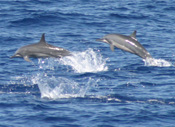Spinner Dolphin (Stenella longirostris)
Status | Taxonomy | Species Description | Habitat | Distribution |
Population Trends | Threats | Conservation Efforts | Regulatory Overview |
Key Documents | More Info
Status
MMPA Depleted - Eastern stock (Stenella longirostris orientalis) in the Eastern Tropical Pacific Ocean
Taxonomy
Kingdom: Animalia
Phylum: Chordata
Class: Mammalia
Order: Cetacea
Family: Delphinidae
Genus: Stenella
Species: longirostris
Subspecies of the spinner dolphin include:
- Eastern spinner (Stenella longirostris orientalis)
- Central American spinner (Stenella longirostris centroamericanus)
- "Whitebelly" spinner (Stenella longirostris longirostris)
Species Description
Like other dolphins of the genus Stenella, spinner dolphins are relatively small, reaching lengths of 6 to 7 feet (2 m) and weighing approximately 130 to 170 pounds (59-77 kg) at adulthood. They have long, slender snouts or beaks. There is a great deal of color variation depending on the region.
Spinner dolphins are best known for their above-water displays of leaping and spinning several times on their body axis. Leaps can often be done in a series with as many as 14 leaps in a row. Spinner dolphins are sometimes found in associations with bottlenose dolphins or humpback whales in Hawaii, which may benefit one or both species.
Mating and calving occurs year-round, with gestation similar to that of most dolphins, around eleven months. Multiple males may mate with one female in short, consecutive intervals. Lactation often takes place for two years, but can also last for only one year. Calving intervals average three years. Maturity occurs at around 7 years of age and maximum longevity is 20 years.
Spinner dolphins often occur in groups of several hundred to several thousand animals. They are considered quite gregarious, often schooling in large groups and with other dolphin species, such as spotted dolphins.
Spinner dolphins feed primarily at night on mid-water fishes and deep-water squid, while resting for most of the daylight hours.
The MMPA "depleted" eastern spinner dolphin (Stenella longirostris orientalis) is one of four named subspecies in the Pacific Ocean.
Habitat
In most places, spinner dolphins are found in the deep ocean where they likely track prey. The Hawaii population has a more coastal distribution. There, the animals rest in bays and protected areas during the day and then fuse into larger groups to feed in deeper water on fish and squid at night.
 Spinner Dolphin Range Map (click for larger view PDF) |
Distribution
The species can be found in all tropical and subtropical oceans. The eastern subspecies is found in the eastern tropical Pacific Ocean (ETP), often in groups of several hundred to several thousand animals.
Population Trends
At the time of the MMPA depleted listing, the eastern spinner dolphin was estimated to be at 44 percent of its pre-exploitation population size. Currently, the eastern stock is estimated to have a population size of 613,000 (Gerrodette et al. 2005). The long-term trend is flat for this stock. The current population sizes of the non-depleted stocks are as follows: Hawaii - 2,800 and Northern Gulf of Mexico - 12,000. See below for links to the most recent stock assessments for the U.S. populations.
Threats
Due to the as yet unexplained association between large yellowfin tuna and some dolphin stocks in the ETP, the presence of the eastern stock of spinner dolphins has been used by the tuna purse-seine fishery to find tuna. Dolphins can become trapped in the nets and drown. Stress from becoming encircled in purse seines has also been documented as a very serious threat to dolphins. Currently, fishing methods for tuna imported into the U.S. under the Dolphin-Safe program do not allow fishing practices, such as setting on dolphins.
Interactions with tourists are a growing threat to the Hawaiian stock; because the species is active at night, daytime interactions with tourists inhibit necessary rest and sleep time.
Conservation Efforts
Spinner dolphins are classified as Lower Risk - Conservation Dependent on the IUCN Redlist ![]() . The International Dolphin Conservation Program Act (IDCPA) [pdf] directed NMFS to determine if the chase and encirclement of dolphins in the purse seine fishery targeting tuna in the ETP is having a significant adverse impact on depleted dolphin stocks. As part of this determination, Congress specified that population surveys be undertaken in 1998, 1999, and 2000 to generate new estimates of dolphin abundance under the IDCPA.
. The International Dolphin Conservation Program Act (IDCPA) [pdf] directed NMFS to determine if the chase and encirclement of dolphins in the purse seine fishery targeting tuna in the ETP is having a significant adverse impact on depleted dolphin stocks. As part of this determination, Congress specified that population surveys be undertaken in 1998, 1999, and 2000 to generate new estimates of dolphin abundance under the IDCPA.
Two programs run by NMFS' Southwest Fisheries Science Center aim to conserve spinner dolphins:
- Dolphin-Safe Program focuses on reducing fishing-related dolphin mortality by developing alternative fishing methods that do not involve dolphins.
- Dolphin Energetics Program focuses on determining whether energetics limitations associated with the fishing practice may be contributing to the observed lack of recovery of fishery-associated dolphin stocks in the ETP.
NMFS developed a viewing guide [pdf] for responsibly viewing spinner dolphins in Hawaii to protect them from excessive disturbance when they rest and socialize.
Regulatory Overview
In 1993, the Eastern spinner dolphin (Stenella longirostris orientalis) stock was designated depleted.
Key Documents
(All documents are in PDF format.)
| Title | Federal Register | Date |
|---|---|---|
| Depleted Designation for Eastern Spinner Dolphins | 50 CFR 216.15 | 08/26/1993 |
| Stock Assessment Reports (Western North Atlantic, Hawaii, Northern Gulf of Mexico) | n/a | various |
- NMFS Pacific Islands Regional Office Spinner Dolphin Information
- NMFS Southwest Fisheries Science Center Spinner Dolphin Information
- NMFS Southwest Region Tuna and Marine Mammals site
- NOAA's National Marine Sanctuaries
- See Video of a Spinner Dolphin Jumping and Spinning

- Hear Spinner Dolphin Sounds

- Ocean Biogeographic Information System (OBIS-SEAMAP) Spinner Dolphin Species Profile
